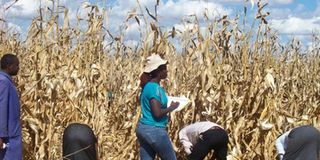Don’t burn crop waste, it is good for the soil

Farmers harvest maize in Kitale. The crop waste is a good source of nutrients. FILE PHOTO |
What you need to know:
- The roots, chaff, stems and leaves left after a crop is harvested are a major source of organic matter.
- Burning destroys the litter layer, reducing the amount of organic matter returned to the soil.
It is that time of the year again when maize farmers have harvested their crop and a lot of waste is on the farm.
To clear the farms in readiness for the next planting season, many farmers will burn the residues.
The most common justification maize, wheat and rice farmers, who are the biggest culprits, give for the practice is that it helps to control insects and diseases and eases ploughing.
But it is important to note that burning of crop waste on the farm is discouraged.
The roots, chaff, stems and leaves left after a crop is harvested are a major source of organic matter.
These residues improve several soil properties such as water infiltration, storage and particle aggregation.
They also contain nutrients, including the nitrogen, phosphorus, potassium and sulphur needed by the plants.
Cereal crop residues, for instance, retain about 25 per cent of nitrogen and phosphorus, 50 per cent of sulphur and 75 per cent of potassium, making them sources of rich nutrients.
The organic matter has been directly and positively linked to soil fertility and increased productivity.
Research shows that organic matter stimulates the growth of soil organisms, which help to make nutrients available to the plants.
Organic matter also binds hydrogen and thus prevents soils from becoming acidic.
DANGERS OF BURNING CROP RESIDUE
Burning destroys the litter layer, reducing the amount of organic matter returned to the soil.
The organisms that inhabit the surface soil and litter layer are also eliminated.
For future decomposition to take place, energy has to be invested first in rebuilding the microbial community before plant nutrients can be released.
Again, the ash that remains after burning contains many nutrients in unusable form.
The first harvest after burning fallow vegetation is usually good. After a few seasons, however, the negative effect of burning starts to show in the level of nutrients in the soil and the low fertility.
During the burning, large amounts of nitrogen and sulphur are released depriving plants of the nutrients.
And after burning, the nutrients that were stored in the vegetation become available in the soil, but they cannot be completely utilised all at once.
Thus in case of heavy rains, large amounts of nitrogen will be leached.
About 40 to 80 per cent of nitrogen in wheat crop residue is lost as ammonia gas when it is burnt in the field.
Data from research shows that a tonne of corn residue contains about 8kg of nitrogen, 2kg of phosphorous and 23kg of potassium.
Thus, based on fertiliser prices, the estimated cost of nutrients removed would be about Sh2,000 per tonne.
If you remove three to four tonnes of residue per acre, the value of nutrients lost would be between Sh6,000 and Sh8,000 per acre.
After burning, the soil is unprotected and, therefore, at great risk to water and wind erosion. Ash is very light and is, therefore, easily carried away by wind and water.
And since the ground is uncovered, the soil temperature during the day rises, which is unfavourable for soil organisms and seed germination. The soil also dries faster and thus becomes hot and empty of organisms.




